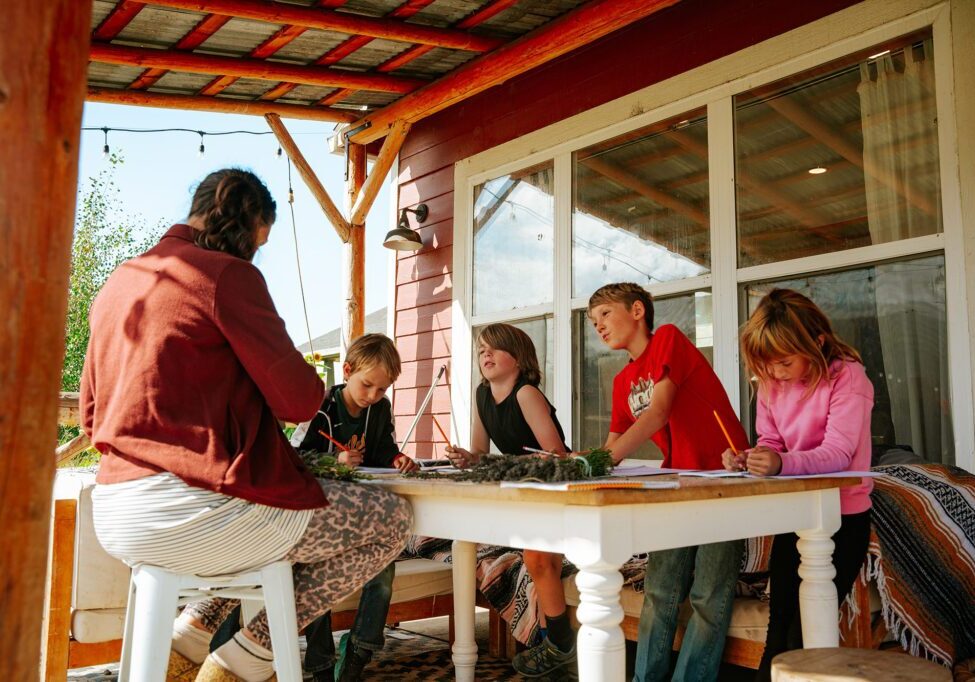As I approach the classroom to pick up my kids, I can hear children’s voices but the dialogue isn’t clear. Judging by the giggles and loud chatter I can tell the class is in the middle of creating a new and very interesting story. Most likely, it is something silly and complete fiction (thus the giggles).
Welcome to early second language learning! Creating stories is a big part of my children’s weekly Spanish class. The children have a great time with their teacher and classmates as they create stories based around simple topics they have all chosen together.
I know I’ll hear all about it later on as my children recount this week’s story to me. If it’s really silly, I’ll hear it more than once; they will be so proud of their creativity that they will retell it to their parents, grandparents and friends. They’ll laugh and talk over each other as they get to the funniest parts.
I have to smile as I consider all the skills they have used and all the brainwork that has gone into having such a good time. How is it they have so much fun that they can’t wait until next week’s class?
It can be fun and engaging. Although they realize that they are learning new vocabulary, they have no idea how much is going on below the surface. They have had to create their own sentences, translating English, sentences into Spanish, and Spanish sentences into English both verbally and in written form. They have had to stand in front of the class and verbally share their ideas in Spanish with the other students.
We know that there are many advantages to having a child learn a second language early in their school career. Learning a new language at a young age allows children to develop more natural, native-sounding speech with a less noticeable accent.
Language learning is physiologically easier for children than it is for adults because children are better able to learn new neuromuscular functions and are able to reproduce a wider variety of sounds, having better pronunciation and intonation.
Redding area Spanish teacher Erin Briller says, “You can learn a language at any age, but children absorb it so well into their developing brains. They don’t overthink it.”
Early second language learning has been noted by researchers to increase cognitive flexibility. These children have better problem-solving and critical thinking skills; they are able to use information in new ways. As demonstrated in my children’s classes, Briller explains that the teaching method entitled “Teaching Proficiency through Reading and Storytelling (TPRS),” works WITH their fun-loving brains.
“We create stories together as a class – all in Spanish – that include the students and topics that are important to them,” explains Briller. “We have fun, and they remember what we talked about. Over time, I find they have acquired much more than I even expect at times. They’re brilliant!”
Debra Moon, Spanish teacher at CORE Butte Charter School in Chico, agrees. Her “Everyday Spanish” class has a long history of being popular with students. Being theme-based and using practical skills, Moon has found that the conversational style really seems to make students better learners. “They are very capable and eager to incorporate their learning into conversations with partners,” she says.
When a child learns a new language, their linguistic abilities are enhanced. Moon has found through her years of experience that the child who has a strong foundation in their home language has an advantage when it comes to learning a second language. Children are able to learn new words and vocabulary easily, and in addition, the students gain a better understanding of their primary language.
Antelope School District Superintendent Rich Hassay supports this idea. “You learn a lot about your own language when learning a new one,” says Hassay. “With many words being derived from Latin, students demonstrate increased vocabulary in both languages.”
Hassay is so committed to early language learning that he and his team will be opening a new 5th through 8th grade charter school this fall. The Lassen-Antelope Volcanic Academy, or LAVA, will offer Spanish class a minimum of three times a week with integration into other subject areas.
Skills that are required in language learning transfer to other academic areas – students can show improved performance in other subjects. Another benefit for children who learn a second language is a better understanding of other cultures. Our world has become increasingly interconnected, and students who have increased global awareness and are able to successfully interact in a global community have more opportunities available to them.
Speaking a second language can open more career paths and help prepare students for the 21st century economy. Superintendent Hassay states that students who speak a second language “have a greater appreciation for cultural diversity, and are better prepared for a global economy.” Briller agrees that learning a second language is invaluable. “It pays to know another language and be able to communicate outside of English speaking circles.”
Stellar Charter School’s Director Patty Furnari also sees the importance of cultural learning. “When students learn through cultural experiences, those experiences are meaningful. They remember and take those experiences home and share them with their families,” she says. “They are absorbing the language and the culture as they share.”
With such a long list of benefits, many families are searching out school programs that offer second language learning. In Northern California, programs currently offered range from full immersion to afterschool language clubs. These programs are growing in popularity and offerings will increase as demand increases.
Be sure to check with your local school district about what programs are available in your area. Having options to choose from will help families find what best fits their children’s needs … and they will likely come home with some great stories to tell!
Comment Policy: All viewpoints are welcome, but comments should remain relevant. Personal attacks, profanity, and aggressive behavior are not allowed. No spam, advertising, or promoting of products/services. Please, only use your real name and limit the amount of links submitted in your comment.
You Might Also Like...
Mi Escuelita Maya Preschool & Children’s Performing Arts Program – A Place of Learning and Inspiration
In a setting best described as welcoming and warm, where diversity is honored and creativity abounds, children go about the business of learning with great enthusiasm. Smiling teachers clearly are […]
Learning Beyond The Books: 5 Skills Smart Kids Need
Raising smart kids isn’t about “teaching to the test,” it’s about building brainpower. Kids who can seek information, connect ideas, and apply what they’ve learned aren’t just book-smart, they are […]

Farm School: Reimagining Education for the Whole Child
What if your child could learn at their own pace, spend much of the day outdoors in nature getting plenty of exercise, synthesizing and integrating academic subjects through hands-on application […]

Siskiyou County Schools Tackle Tobacco
“Eighty-one percent of California teenagers prefer dating non-smokers,” recites Maya, a Butteville Elementary sixth grade student who is rehearsing for one of a series of recorded tobacco awareness ads to […]



